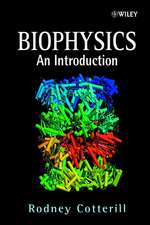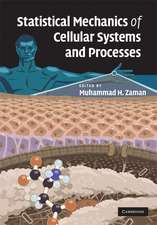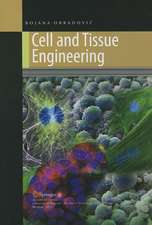Biophotonics: Biological and Medical Physics, Biomedical Engineering
Editat de Lorenzo Pavesi, Philippe M. Faucheten Limba Engleză Hardback – 19 aug 2008
| Toate formatele și edițiile | Preț | Express |
|---|---|---|
| Paperback (1) | 790.03 lei 38-44 zile | |
| Springer Berlin, Heidelberg – 23 noi 2010 | 790.03 lei 38-44 zile | |
| Hardback (1) | 952.89 lei 6-8 săpt. | |
| Springer Berlin, Heidelberg – 19 aug 2008 | 952.89 lei 6-8 săpt. |
Din seria Biological and Medical Physics, Biomedical Engineering
- 5%
 Preț: 1110.32 lei
Preț: 1110.32 lei - 18%
 Preț: 1006.55 lei
Preț: 1006.55 lei - 18%
 Preț: 960.78 lei
Preț: 960.78 lei - 18%
 Preț: 704.11 lei
Preț: 704.11 lei - 18%
 Preț: 967.40 lei
Preț: 967.40 lei - 18%
 Preț: 948.92 lei
Preț: 948.92 lei - 15%
 Preț: 641.71 lei
Preț: 641.71 lei - 15%
 Preț: 644.95 lei
Preț: 644.95 lei - 15%
 Preț: 665.08 lei
Preț: 665.08 lei - 18%
 Preț: 1669.16 lei
Preț: 1669.16 lei - 18%
 Preț: 941.05 lei
Preț: 941.05 lei - 18%
 Preț: 956.81 lei
Preț: 956.81 lei - 18%
 Preț: 950.21 lei
Preț: 950.21 lei - 15%
 Preț: 636.80 lei
Preț: 636.80 lei - 18%
 Preț: 947.50 lei
Preț: 947.50 lei - 15%
 Preț: 636.80 lei
Preț: 636.80 lei -
 Preț: 397.01 lei
Preț: 397.01 lei - 18%
 Preț: 1236.99 lei
Preț: 1236.99 lei - 15%
 Preț: 644.49 lei
Preț: 644.49 lei - 18%
 Preț: 946.55 lei
Preț: 946.55 lei - 15%
 Preț: 712.22 lei
Preț: 712.22 lei - 18%
 Preț: 944.36 lei
Preț: 944.36 lei - 18%
 Preț: 1228.29 lei
Preț: 1228.29 lei - 5%
 Preț: 1422.67 lei
Preț: 1422.67 lei - 18%
 Preț: 1393.27 lei
Preț: 1393.27 lei - 15%
 Preț: 651.19 lei
Preț: 651.19 lei - 18%
 Preț: 953.65 lei
Preț: 953.65 lei - 18%
 Preț: 955.88 lei
Preț: 955.88 lei - 15%
 Preț: 644.95 lei
Preț: 644.95 lei - 5%
 Preț: 1098.48 lei
Preț: 1098.48 lei - 18%
 Preț: 959.19 lei
Preț: 959.19 lei - 15%
 Preț: 643.65 lei
Preț: 643.65 lei - 5%
 Preț: 1159.16 lei
Preț: 1159.16 lei - 5%
 Preț: 1102.67 lei
Preț: 1102.67 lei - 18%
 Preț: 952.09 lei
Preț: 952.09 lei - 18%
 Preț: 946.55 lei
Preț: 946.55 lei - 18%
 Preț: 952.09 lei
Preț: 952.09 lei - 15%
 Preț: 703.20 lei
Preț: 703.20 lei - 18%
 Preț: 953.65 lei
Preț: 953.65 lei - 5%
 Preț: 1008.45 lei
Preț: 1008.45 lei - 15%
 Preț: 644.82 lei
Preț: 644.82 lei - 18%
 Preț: 956.03 lei
Preț: 956.03 lei - 15%
 Preț: 647.40 lei
Preț: 647.40 lei
Preț: 952.89 lei
Preț vechi: 1162.06 lei
-18% Nou
Puncte Express: 1429
Preț estimativ în valută:
182.36€ • 198.01$ • 153.18£
182.36€ • 198.01$ • 153.18£
Carte tipărită la comandă
Livrare economică 22 aprilie-06 mai
Preluare comenzi: 021 569.72.76
Specificații
ISBN-13: 9783540767794
ISBN-10: 3540767797
Pagini: 374
Ilustrații: XXII, 336 p.
Dimensiuni: 155 x 235 x 30 mm
Greutate: 0.66 kg
Ediția:2008
Editura: Springer Berlin, Heidelberg
Colecția Springer
Seria Biological and Medical Physics, Biomedical Engineering
Locul publicării:Berlin, Heidelberg, Germany
ISBN-10: 3540767797
Pagini: 374
Ilustrații: XXII, 336 p.
Dimensiuni: 155 x 235 x 30 mm
Greutate: 0.66 kg
Ediția:2008
Editura: Springer Berlin, Heidelberg
Colecția Springer
Seria Biological and Medical Physics, Biomedical Engineering
Locul publicării:Berlin, Heidelberg, Germany
Public țintă
ResearchCuprins
Light Conversion in Photosynthetic Organisms.- Exploiting Photosynthesis for Biofuel Production.- In Between Photosynthesis and Photoinhibition: The Fundamental Role of Carotenoids and Carotenoid-Binding Proteins in Photoprotection.- Non-Linear Microscopy.- Applications of Optical Resonance to Biological Sensing and Imaging: I. Spectral Self-Interference Microscopy.- Applications of Optical Resonance to Biological Sensing and Imaging: II. Resonant Cavity Biosensors.- Biodetection Using Silicon Photonic Crystal Microcavities.- Optical Coherence Tomography with Applications in Cancer Imaging.- Coherent Laser Measurement Techniques for Medical Diagnostics.- Biomarkers and Luminescent Probes in Quantitative Biology.- Fluorescence-Based Optical Biosensors.- Optical Biochips.- CMOS Single-Photon Systems for Bioimaging Applications.- Optical Trapping and Manipulation for Biomedical Applications.- Laser Tissue Welding in Minimally Invasive Surgery and Microsurgery.- Photobiology of the Skin.- Advanced Photodynamic Therapy.
Recenzii
From the reviews:
“All ideas are introduced on a level that can be easily grasped by either a physicist or a biologist – starting from advanced undergraduates through to post-doctoral researchers. … Biophotonics is highly recommended to anyone from graduate students in their final years at university to academics, providing a detailed introduction … in key areas of biophotonics. … provide a solid base for building up a curriculum for a course in biophotonics, biophysics or related subjects and to provide a key reading material for such subjects.” (Oleg Kolosov, Contemporary Physics, Vol. 51 (4), 2010)
“All ideas are introduced on a level that can be easily grasped by either a physicist or a biologist – starting from advanced undergraduates through to post-doctoral researchers. … Biophotonics is highly recommended to anyone from graduate students in their final years at university to academics, providing a detailed introduction … in key areas of biophotonics. … provide a solid base for building up a curriculum for a course in biophotonics, biophysics or related subjects and to provide a key reading material for such subjects.” (Oleg Kolosov, Contemporary Physics, Vol. 51 (4), 2010)
Notă biografică
Lorenzo Pavesi is Professor of experimental physics at the university of Trento (Italy). Born the 21st of november 1961, he received the phd in physics in 1990 at the ecole polytechnique federale of lausanne (switzerland). in 1990 he became assistant professor, an associate professor in 1999 and full professor in 2002 at the university of Trento. He founded the research activity in semiconductor optoelectronics at the university of Trento and started several laboratories of optical spectroscopy, growth and advanced treatment of materials. During the last years, he concentrated on Si-based photonics, of which is one the leading experts worldwide. Recently his interested moved to nanoscience including nanobiotechnology and to the convergence of the nano- with the microtechnologies.
Professor Philippe Fauchet is a Distinguished Professor of Electrical and Computer Engineering at the University of Rochester (USA), where he is also Professor of Optics, Biomedical Engineering, and Materials Science. He received his Ph.D. in Applied Physics from Stanford University in 1984 and taught at Stanford and Princeton Universities before joining the University of Rochester in 1990. His research areas are in nanoscience and nanotechnology with silicon, optical and electrical biosensors, electroluminescent materials and devices, and optical diagnostics. In 1998, he founded the Center for Future Health, a multidisciplinary center involving scientists, engineers, physicians, nurses, and social scientist working together to develop devices and systems that can keep people healthy. He is a Fellow of the Optical Society of America, the American Physical Society, and the Institute of Electrical and Electronic Engineering.
Professor Philippe Fauchet is a Distinguished Professor of Electrical and Computer Engineering at the University of Rochester (USA), where he is also Professor of Optics, Biomedical Engineering, and Materials Science. He received his Ph.D. in Applied Physics from Stanford University in 1984 and taught at Stanford and Princeton Universities before joining the University of Rochester in 1990. His research areas are in nanoscience and nanotechnology with silicon, optical and electrical biosensors, electroluminescent materials and devices, and optical diagnostics. In 1998, he founded the Center for Future Health, a multidisciplinary center involving scientists, engineers, physicians, nurses, and social scientist working together to develop devices and systems that can keep people healthy. He is a Fellow of the Optical Society of America, the American Physical Society, and the Institute of Electrical and Electronic Engineering.
Textul de pe ultima copertă
More profound understanding of the nature of light and light-matter interactions in biology has enabled many applications in the biology and medical fields. So a new discipline is born, namely biophotonics. The aim of this book is to review the current state-of-the-art of the field by means of authoritative chapters written by the world leaders of the respective fields. Biosensors, biochips, optical tomography, optical microsurgery, photodynamics therapy, bioactivation of gene, photobiology of skin, and nanobiophotonics are each introduced and recent advances presented. This book will be useful not only to physicians, biologists, physicists, chemists, materials scientists, and engineers but also to graduate students who are interested in these rapidly developing fields.
Caracteristici
Deals with the basics and applications of the most advanced optical methods in biology and medicine for cancer diagnosis and treatment or gene analysis Written for researchers and medical practitioners in optical tomography, cancer treatment and research, ophthalmologists, surgeons, gene research and diagnosis But also appealing to biologists in photobiology as well as graduate students Offers many insights into important new processes, such as optical biochip analysis, photobiology of skin and optical microsurgery
















